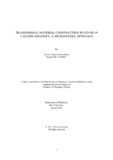| dc.contributor.advisor | Uddin, Md. Jasim | |
| dc.contributor.author | Chowdhury, Tasnia Farheen | |
| dc.date.accessioned | 2021-10-21T05:36:17Z | |
| dc.date.available | 2021-10-21T05:36:17Z | |
| dc.date.copyright | 2021 | |
| dc.date.issued | 2021-08 | |
| dc.identifier.other | ID 17346011 | |
| dc.identifier.uri | http://hdl.handle.net/10361/15508 | |
| dc.description | This thesis is submitted in partial fulfillment of the requirements for the degree of Bachelor of Pharmacy, 2021. | en_US |
| dc.description | Cataloged from PDF version of thesis report. | |
| dc.description | Includes bibliographical references (pages 42-52). | |
| dc.description.abstract | COVID-19 has an impact on people of all ages, races, and ethnicities. Because many infected persons are asymptomatic, the virus is unknowingly transmitted to others, resulting in a rapid spread of illness. Spike protein (S) of coronavirus is a distinctive secondary element of the viral envelope which is regarded as a major target of antibodies designed to detect coronavirus contamination. Microneedle methods, particularly dissolving microneedles, are very helpful and beneficial for achieving herd immunity in the population. There will be increased immunogenicity, less vaccination waste, customized distribution, and so forth. Hollow microneedles and solid microneedles are also viable options for producing the vaccine of COVID-19, and the materials used to make them include ceramic, polymers, carbohydrates, hydrogels, and so on. In order to protect people in this worldwide epidemic, this may be an excellent way of vaccinating against this lethal virus while also ensuring patient compliance. | en_US |
| dc.description.statementofresponsibility | Tasnia Farheen Chowdhury | |
| dc.format.extent | 52 pages | |
| dc.language.iso | en | en_US |
| dc.publisher | Brac University | en_US |
| dc.rights | Brac University theses are protected by copyright. They may be viewed from this source for any purpose, but reproduction or distribution in any format is prohibited without written permission. | |
| dc.subject | Covid-19 | en_US |
| dc.subject | Vaccination | en_US |
| dc.subject | Transdermal | en_US |
| dc.subject | Microneedles | en_US |
| dc.subject.lcsh | COVID-19 (Disease) | |
| dc.subject.lcsh | Vaccines | |
| dc.subject.lcsh | Transdermal medication | |
| dc.title | Transdermal material construction in covid 19 vaccine delivery: a microneedle approach | en_US |
| dc.type | Thesis | en_US |
| dc.contributor.department | Department of Pharmacy, Brac University | |
| dc.description.degree | B. Pharmacy | |

